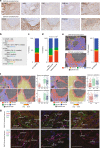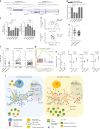miR200-regulated CXCL12β promotes fibroblast heterogeneity and immunosuppression in ovarian cancers
- PMID: 29535360
- PMCID: PMC5849633
- DOI: 10.1038/s41467-018-03348-z
miR200-regulated CXCL12β promotes fibroblast heterogeneity and immunosuppression in ovarian cancers
Abstract
High-grade serous ovarian cancers (HGSOC) have been subdivided into molecular subtypes. The mesenchymal HGSOC subgroup, defined by stromal-related gene signatures, is invariably associated with poor patient survival. We demonstrate that stroma exerts a key function in mesenchymal HGSOC. We highlight stromal heterogeneity in HGSOC by identifying four subsets of carcinoma-associated fibroblasts (CAF-S1-4). Mesenchymal HGSOC show high content in CAF-S1 fibroblasts, which exhibit immunosuppressive functions by increasing attraction, survival, and differentiation of CD25+FOXP3+ T lymphocytes. The beta isoform of the CXCL12 chemokine (CXCL12β) specifically accumulates in the immunosuppressive CAF-S1 subset through a miR-141/200a dependent-mechanism. Moreover, CXCL12β expression in CAF-S1 cells plays a crucial role in CAF-S1 immunosuppressive activity and is a reliable prognosis factor in HGSOC, in contrast to CXCL12α. Thus, our data highlight the differential regulation of the CXCL12α and CXCL12β isoforms in HGSOC, and reveal a CXCL12β-associated stromal heterogeneity and immunosuppressive environment in mesenchymal HGSOC.
Conflict of interest statement
The authors declare no competing interests.
Figures






Similar articles
-
Fibroblast Heterogeneity and Immunosuppressive Environment in Human Breast Cancer.Cancer Cell. 2018 Mar 12;33(3):463-479.e10. doi: 10.1016/j.ccell.2018.01.011. Epub 2018 Feb 15. Cancer Cell. 2018. PMID: 29455927
-
Effect of fibroblast heterogeneity on prognosis and drug resistance in high-grade serous ovarian cancer.Sci Rep. 2024 Nov 4;14(1):26617. doi: 10.1038/s41598-024-77630-0. Sci Rep. 2024. PMID: 39496775 Free PMC article.
-
[CXCL12α and CXCL12β stimulate the migration of cultured LX-2 hepatic stellate cells].Xi Bao Yu Fen Zi Mian Yi Xue Za Zhi. 2015 Mar;31(3):293-6. Xi Bao Yu Fen Zi Mian Yi Xue Za Zhi. 2015. PMID: 25744829 Chinese.
-
Studying platinum sensitivity and resistance in high-grade serous ovarian cancer: Different models for different questions.Drug Resist Updat. 2016 Jan;24:55-69. doi: 10.1016/j.drup.2015.11.005. Epub 2015 Nov 26. Drug Resist Updat. 2016. PMID: 26830315 Review.
-
Exploring the Role of Fallopian Ciliated Cells in the Pathogenesis of High-Grade Serous Ovarian Cancer.Int J Mol Sci. 2018 Aug 24;19(9):2512. doi: 10.3390/ijms19092512. Int J Mol Sci. 2018. PMID: 30149579 Free PMC article. Review.
Cited by
-
Metabolic reprogramming and crosstalk of cancer-related fibroblasts and immune cells in the tumor microenvironment.Front Endocrinol (Lausanne). 2022 Aug 15;13:988295. doi: 10.3389/fendo.2022.988295. eCollection 2022. Front Endocrinol (Lausanne). 2022. PMID: 36046791 Free PMC article. Review.
-
Fibroblast diversity and plasticity in the tumor microenvironment: roles in immunity and relevant therapies.Cell Commun Signal. 2023 Sep 18;21(1):234. doi: 10.1186/s12964-023-01204-2. Cell Commun Signal. 2023. PMID: 37723510 Free PMC article. Review.
-
Macrophages as regulators of tumour immunity and immunotherapy.Nat Rev Immunol. 2019 Jun;19(6):369-382. doi: 10.1038/s41577-019-0127-6. Nat Rev Immunol. 2019. PMID: 30718830 Free PMC article. Review.
-
Comprehensive analysis of mRNA-level and miRNA-level subpathway activities for identifying robust ovarian cancer prognostic signatures.J Cell Mol Med. 2020 Feb;24(4):2582-2592. doi: 10.1111/jcmm.14968. Epub 2020 Jan 19. J Cell Mol Med. 2020. PMID: 31957240 Free PMC article.
-
Assessing personalized responses to anti-PD-1 treatment using patient-derived lung tumor-on-chip.Cell Rep Med. 2024 May 21;5(5):101549. doi: 10.1016/j.xcrm.2024.101549. Epub 2024 May 3. Cell Rep Med. 2024. PMID: 38703767 Free PMC article.
References
Publication types
MeSH terms
Substances
LinkOut - more resources
Full Text Sources
Other Literature Sources
Medical

